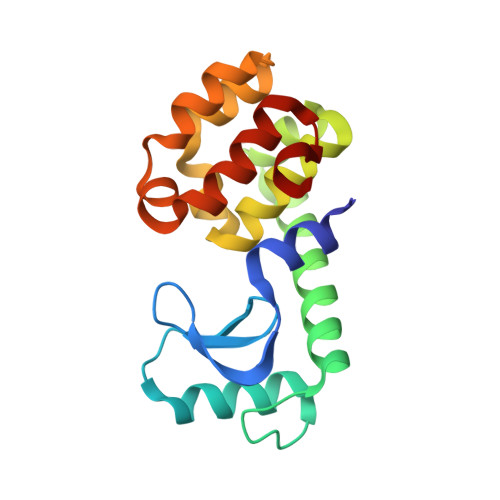Size versus polarizability in protein-ligand interactions: binding of noble gases within engineered cavities in phage T4 lysozyme.
Quillin, M.L., Breyer, W.A., Griswold, I.J., Matthews, B.W.(2000) J Mol Biol 302: 955-977
- PubMed: 10993735
- DOI: https://doi.org/10.1006/jmbi.2000.4063
- Primary Citation of Related Structures:
1C60, 1C61, 1C62, 1C63, 1C64, 1C65, 1C66, 1C67, 1C68, 1C69, 1C6A, 1C6B, 1C6C, 1C6D, 1C6E, 1C6F, 1C6G, 1C6H, 1C6I, 1C6J, 1C6K, 1C6L, 1C6M, 1C6N, 1C6P, 1C6Q, 1C6T - PubMed Abstract:
To investigate the relative importance of size and polarizability in ligand binding within proteins, we have determined the crystal structures of pseudo wild-type and cavity-containing mutant phage T4 lysozymes in the presence of argon, krypton, and xenon. These proteins provide a representative sample of predominantly apolar cavities of varying size and shape. Even though the volumes of these cavities range up to the equivalent of five xenon atoms, the noble gases bind preferentially at highly localized sites that appear to be defined by constrictions in the walls of the cavities, coupled with the relatively large radii of the noble gases. The cavities within pseudo wild-type and L121A lysozymes each bind only a single atom of noble gas, while the cavities within mutants L133A and F153A have two independent binding sites, and the L99A cavity has three interacting sites. The binding of noble gases within two double mutants was studied to characterize the additivity of binding at such sites. In general, when a cavity in a protein is created by a "large-to-small" substitution, the surrounding residues relax somewhat to reduce the volume of the cavity. The binding of xenon and, to a lesser degree, krypton and argon, tend to expand the volume of the cavity and to return it closer to what it would have been had no relaxation occurred. In nearly all cases, the extent of binding of the noble gases follows the trend xenon>krypton>argon. Pressure titrations of the L99A mutant have confirmed that the crystallographic occupancies accurately reflect fractional saturation of the binding sites. The trend in noble gas affinity can be understood in terms of the effects of size and polarizability on the intermolecular potential. The plasticity of the protein matrix permits repulsion due to increased ligand size to be more than compensated for by attraction due to increased ligand polarizability. These results have implications for the mechanism of general anesthesia, the migration of small ligands within proteins, the detection of water molecules within apolar cavities and the determination of crystallographic phases.
Organizational Affiliation:
Institute of Molecular Biology Howard Hughes Medical Institute and Department of Physics, University of Oregon, Eugene, OR, 97403, USA.

















